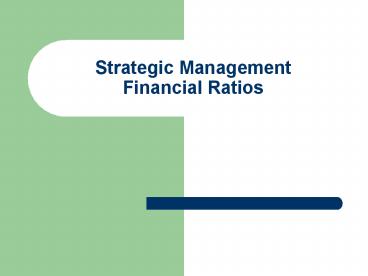Strategic Management Financial Ratios - PowerPoint PPT Presentation
1 / 17
Title:
Strategic Management Financial Ratios
Description:
Strategic Management Financial Ratios Strategic Ratios Profit Ratios Liquidity Ratios Activity Ratios Leverage Ratios Shareholder-Return Ratios Profit Ratios Profit ... – PowerPoint PPT presentation
Number of Views:93
Avg rating:3.0/5.0
Title: Strategic Management Financial Ratios
1
Strategic ManagementFinancial Ratios
2
Strategic Ratios
- Profit Ratios
- Liquidity Ratios
- Activity Ratios
- Leverage Ratios
- Shareholder-Return Ratios
3
Profit Ratios
- Profit Ratios Profit ratios measure the
efficiency with which the company uses its
resources. The more efficient the company, the
greater is its profitability. It is useful to
compare a company's profitability against that of
its major competitors in its industry. Such a
comparison tells whether the company is operating
more or less efficiently than its rivals. In
addition, the change in a company's profit ratios
over time tells whether its performance is
improving or declining.
4
Profit Ratios (Continued)
- Gross profit margin. The gross profit margin
simply gives the percentage of sales available to
cover general and administrative expenses and
other operating costs. - Gross Profit Margin Sales Revenue - Cost of
Goods Sold -
Sales Revenue
5
Profit Ratios (Continued)
- Net profit margin. Net profit margin is the
percentage of profit earned on sales. This ratio
is important because businesses need to make a
profit to survive in the long run. - Net Profit Margin Net Income
- Sales Revenue
6
Profit Ratios (Continued)
- Return on total assets. This ratio measures the
profit earned on the employment of assets. - Return on Total Assets Net Income Available to
Common Stockholders -
Total Assets - Net income is the profit after preferred
dividends (those set by contract) have been paid.
Total assets include both current and non-current
assets.
7
Profit Ratios (Continued)
- Return on stockholders' equity. This ratio
measures the percentage of profit earned on
common stockholders' investment in the company.
In theory, a company attempting to maximize the
wealth of its stockholders should be trying to
maximize this ratio. - Return on Stockholders' Equity Net Income
Available to Common Stockholders - Stockholders' Equity
8
Liquidity Ratios
- A company's liquidity is a measure of its ability
to meet short-term obligations. An asset is
deemed liquid if it can be readily converted into
cash. Liquid assets are current assets such as
cash, marketable securities, accounts receivable,
and so on.
9
Liquidity Ratios (Continued)
- Current ratio. The current ratio measures the
extent to which the claims of short-term
creditors are covered by assets that can be
quickly converted into cash. Most companies
should have a ratio of at least 1, because
failure to meet these commitments can lead to
bankruptcy. - Current Ratio Current Assets
- Current Liabilities
10
Liquidity Ratios (Continued)
- Quick ratio. The quick ratio measures a company's
ability to payoff the claims of short-term
creditors without relying on the sale of its
inventories. This is a valuable measure since in
practice the sale of inventories is often
difficult. - Quick Ratio Current Assets - Inventory
- Current Liabilities
11
Activity Ratios
- Activity ratios indicate how effectively a
company is managing its assets - Inventory turnover. This measures the number of
times inventory is turned over. It is useful in
determining whether a firm is carrying excess
stock in inventory. - Days sales outstanding (DSO), or average
collection period. This ratio is the average
time a company has to wait to receive its cash
after making a sale. It measures how effective
the company's credit, billing, and collection
procedures are.
12
Leverage Ratios
- A company is said to be highly leveraged if it
uses more debt than equity, including stock and
retained earnings. The balance between debt and
equity is called the capital structure. The
optimal capital structure is determined by the
individual company. - Debt has a lower cost because creditors take less
risk they know they will get their interest and
principal. However, debt can be risky to the firm
because if enough profit is not made to cover the
interest and principal payments, bankruptcy can
occur.
13
Leverage Ratios (Continued)
- Debt-to-assets ratio. The debt-to-asset ratio is
the most direct measure of the extent to which
borrowed funds have been used to finance a
company's investments. It is defined as follows - Debt-to-Assets Ratio Total Debt
- Total Assets
- Total debt is the sum of a company's current
liabilities and its long-term debt, and total
assets are the sum of fixed assets and current
assets.
14
Leverage Ratios (Continued)
- Debt-to-equity ratio. The debt-to-equity ratio
indicates the balance between debt and equity in
a company's capital structure. This is perhaps
the most widely used measure of a company's
leverage. It is defined as follows - Debt-to-Equity Ratio Total Debt
- Total Equity
15
Shareholder-Return Ratios
- Shareholder-return ratios measure the return
earned by shareholders from holding stock in the
company. Given the goal of maximizing
stockholders' wealth, providing shareholders with
an adequate rate of return is a primary objective
of most companies. As with profit ratios, it can
be helpful to compare a company's shareholders
returns against those of similar companies. This
provides a yardstick for determining how well the
company is satisfying the demands of this
particularly important group of organizational
constituents.
16
Shareholder-Return Ratios (Continued)
- Price-earnings ratio. The price-earnings ratio
measures the amount investors are willing to pay
per dollar of profit. - Price-Earnings Ratio Market Price per Share
- Earnings
per Share
17
Shareholder-Return Ratios (Continued)
- Market to book value. Another useful ratio is
market to book value. This measures a company's
expected future growth prospects. - Market to Book Value Market Price per Share
- Book value per
share of equity































